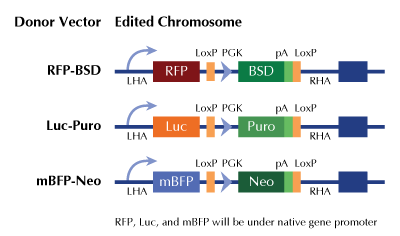Abcg2 Mouse Gene Knockout Kit (CRISPR)
CAT#: KN300640BN
Abcg2 - mouse gene knockout kit via CRISPR, HDR mediated
Functional Cassette: GFP-puro Luciferase-Puro RFP-BSD
HDR-mediated knockout kit validation
USD 1,657.00
4 Weeks*
Specifications
| Product Data | |
| Format | 2 gRNA vectors, 1 mBFP-Neo donor, 1 scramble control |
| Donor DNA | mBFP-Neo |
| Symbol | Abcg2 |
| Locus ID | 26357 |
| Components |
KN300640G1, Abcg2 gRNA vector 1 in pCas-Guide CRISPR vector KN300640G2, Abcg2 gRNA vector 2 in pCas-Guide CRISPR vector KN300640BND, donor DNA containing left and right homologous arms and mBFP-Neo functional cassette. GE100003, scramble sequence in pCas-Guide vector |
| Disclaimer | These products are manufactured and supplied by OriGene under license from ERS. The kit is designed based on the best knowledge of CRISPR technology. The system has been functionally validated for knocking-in the cassette downstream the native promoter. The efficiency of the knock-out varies due to the nature of the biology and the complexity of the experimental process. |
| Reference Data | |
| RefSeq | NM_011920, NM_001355477 |
| UniProt ID | Q7TMS5 |
| Synonyms | ABC15; ABCP; AI428558; BCRP; Bcrp1; MXR; MXR1 |
| Summary | The membrane-associated protein encoded by this gene is included in the superfamily of ATP-binding cassette (ABC) transporters. ABC proteins transport various molecules across extra- and intra-cellular membranes. ABC genes are divided into seven distinct subfamilies (ABC1, MDR/TAP, MRP, ALD, OABP, GCN20, White). This protein is a member of the White subfamily. Alternatively referred to as a breast cancer resistance protein, the human protein functions as a xenobiotic transporter which may play a major role in multi-drug resistance. This protein likely serves as a cellular defense mechanism in response to mitoxantrone and anthracycline exposure. [provided by RefSeq, Jul 2008] |
Documents
| Product Manuals |
| FAQs |
| SDS |
Resources
Other Versions
| SKU | Description | Size | Price |
|---|---|---|---|
| KN300640 | Abcg2 - mouse gene knockout kit via CRISPR, HDR mediated |
USD 1,657.00 |
|
| KN300640LP | Abcg2 - mouse gene knockout kit via CRISPR, HDR mediated |
USD 1,657.00 |
|
| KN300640RB | Abcg2 - mouse gene knockout kit via CRISPR, HDR mediated |
USD 1,657.00 |
|
| KN500640 | Abcg2 - KN2.0, Mouse gene knockout kit via CRISPR, non-homology mediated. |
USD 1,657.00 |
|
| GA204916 | Abcg2 CRISPRa kit - CRISPR gene activation of mouse ATP binding cassette subfamily G member 2 (Junior blood group) |
USD 1,657.00 |
{0} Product Review(s)
Be the first one to submit a review






























































































































































































































































 Germany
Germany
 Japan
Japan
 United Kingdom
United Kingdom
 China
China
